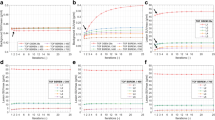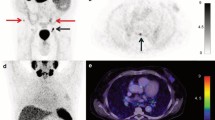Abstract
Objectives
When increasing the PET acquisition time to match the longer MRI protocol in simultaneous PET/MR, the injected PET tracer dose can possibly be lowered to reduce radiation exposure. Moreover, applying new commercially available time-of-flight (TOF) block sequential regularized expectation maximization (BSREM)–based reconstruction algorithms could allow for further dose reductions. The purpose of this study was to find the minimal dose of the tracer targeting the prostate specific membrane antigen (68Ga-PSMA-11) for a dedicated 15-min pelvic PET/MR scan that still matches the image quality of a reference 3-min scan at 100% (150 MBq) dose.
Methods
In this retrospective analysis, 25 patients were included. PET emission datasets were edited to simulate stepwise reductions of injected tracer dose. Reference TOF ordered subset expectation maximum (OSEM) and new TOF BSREM reconstructions were performed and differences in the resulting PET images were visually and quantitatively assessed.
Results
Visually, TOF BSREM reconstructions with relatively high regularization parameter (β) values are preferred. Quantitatively, however, high β-values result in lower lesion maximum standardized uptake values (SUVmax) compared to the reference. A β-value of 550 was considered the optimal compromise for the lowest possible 10% dose reconstructions, resulting in comparable visual assessment and lesion SUVmax.
Conclusions
This study indicates that the injected 68Ga-PSMA-11 tracer dose for a standard 3-min PET scan can be reduced to approximately 10% (15 MBq) when the PET acquisition time is matched to the 15-min pelvic MRI protocol, and when reconstructed with TOF BSREM using β = 550. This decreases the effective dose from 3.54 to 0.35 mSv.
Key Points
• Low-dose dedicated pelvic 68 Ga-PSMA-11 PET/MR reduces radiation exposure for patients.
• Retrospective study investigating the minimal dose needed for adequate image quality for 15-min PET frames over the pelvis showed using quantitative and qualitative analysis that a substantial dose reduction is possible without significant loss of image quality when using the TOF BSREM reconstruction algorithm.
• With the introduction of low-dose pelvic 68 Ga-PSMA-11 PET/MR, new potential applications of 68 Ga-PSMA-11 PET for local staging or investigation of equivocal MRI findings could become applicable, even for patients without confirmed prostate cancer.




Similar content being viewed by others
Abbreviations
- 18F-FDG:
-
Glucose analog tracer labeled with fluorine-18, (2-deoxy-2-(18F)fluoro-d-glucose)
- 68Ga-PSMA-11:
-
Tracer labeled with gallium-68, targeting the prostate specific membrane antigen (PSMA)
- β (beta):
-
Regularization parameter in BSREM
- BSREM:
-
Block sequential regularized expectation maximization
- FoV:
-
Field-of-view
- MIP:
-
Maximum intensity projection
- mpMRI:
-
Multiparametric magnetic resonance imaging
- OSEM:
-
Ordered subset expectation maximization
- PCa:
-
Prostate cancer
- PSMA:
-
Prostate-specific membrane antigen
- SUV:
-
Standardized uptake value
- TOF:
-
Time-of-flight
- VOI:
-
Volume of interest
References
Eiber M, Weirich G, Holzapfel K et al (2016) Simultaneous (68)Ga-PSMA HBED-CC PET/MRI improves the localization of primary prostate cancer. Eur Urol 70:829–836
Park SY, Zacharias C, Harrison C et al (2018) Gallium 68 PSMA-11 PET/MR imaging in patients with intermediate- or high-risk prostate cancer. Radiology 288:495–505
Silver DA, Pellicer I, Fair WR, Heston WD, Cordon-Cardo C (1997) Prostate-specific membrane antigen expression in normal and malignant human tissues. Clin Cancer Res 3:81–85
Domachevsky L, Bernstine H, Goldberg N, Nidam M, Catalano OA, Groshar D (2019) Comparison between pelvic PSMA-PET/MR and whole-body PSMA-PET/CT for the initial evaluation of prostate cancer: a proof of concept study. Eur Radiol. https://doi.org/10.1007/s00330-019-06353-y
Boellaard R, Quick HH (2015) Current image acquisition options in PET/MR. Semin Nucl Med 45:192–200
Qi J, Leahy RM (2006) Iterative reconstruction techniques in emission computed tomography. Phys Med Biol 51:R541–R578
Boellaard R, van Lingen A, Lammertsma AA (2001) Experimental and clinical evaluation of iterative reconstruction (OSEM) in dynamic PET: quantitative characteristics and effects on kinetic modeling. J Nucl Med 42:808–817
Liow JS, Strother SC (1993) The convergence of object dependent resolution in maximum likelihood based tomographic image reconstruction. Phys Med Biol 38:55–70
Asma E, Manjeshwar R (2007) Analysis of organ uniformity in low count density penalized likelihood PET images. 2007 IEEE Nuclear Science Symposium Conference Record, pp 4426–4432
Asma E, Ahn S, Ross SG, Chen A, Manjeshwar RM (2012) Accurate and consistent lesion quantitation with clinically acceptable penalized likelihood images. 2012 IEEE Nuclear Science Symposium and Medical Imaging Conference Record (NSS/MIC), pp 4062–4066
Geman S, Geman D (1984) Stochastic relaxation, Gibbs distributions, and the Bayesian restoration of images. IEEE Trans Pattern Anal Mach Intell 6:721–741
Geman S, McClure D (1985) Bayesian image analysis methods: an application to single photon emission computed tomography. Proc Statistical Computation Section, pp 12–18
Mumcuoglu EU, Leahy RM, Cherry SR (1996) Bayesian reconstruction of PET images: methodology and performance analysis. Phys Med Biol 41:1777–1807
Ahn S, Ross SG, Asma E et al (2015) Quantitative comparison of OSEM and penalized likelihood image reconstruction using relative difference penalties for clinical PET. Phys Med Biol 60:5733
Sah BR, Stolzmann P, Delso G et al (2017) Clinical evaluation of a block sequential regularized expectation maximization reconstruction algorithm in 18F-FDG PET/CT studies. Nucl Med Commun 38:57–66
Teoh EJ, McGowan DR, Macpherson RE, Bradley KM, Gleeson FV (2015) Phantom and clinical evaluation of the Bayesian penalized likelihood reconstruction algorithm Q.Clear on an LYSO PET/CT system. J Nucl Med 56:1447–1452
Ter Voert EEGV, Muehlematter UJ, Delso G et al (2018) Quantitative performance and optimal regularization parameter in block sequential regularized expectation maximization reconstructions in clinical (68)Ga-PSMA PET/MR. EJNMMI Res 8:70
Fendler WP, Eiber M, Beheshti M et al (2017) (68)Ga-PSMA PET/CT: joint EANM and SNMMI procedure guideline for prostate cancer imaging: version 1.0. Eur J Nucl Med Mol Imaging 44:1014–1024
Huang SY, Savic D, Yang J, Shrestha U, Seo Y (2014) The effect of magnetic field on positron range and spatial resolution in an integrated whole-body time-of-flight PET/MRI system. IEEE Nucl Sci Symp Conf Rec (1997) 2014
Levin C, Glover G, Deller T, McDaniel D, Peterson W, Maramraju SH (2013) Prototype time-of-flight PET ring integrated with a 3T MRI system for simultaneous whole-body PET/MR imaging. J Nucl Med Meeting Abstracts 54:148
Wollenweber SD, Ambwani S, Delso G et al (2013) Evaluation of an atlas-based PET head attenuation correction using PET/CT & MR patient data. IEEE Trans Nucl Sci 60:3383–3390
Wollenweber SD, Ambwani S, Lonn AHR et al (2013) Comparison of 4-class and continuous fat/water methods for whole-body, MR-based PET attenuation correction. IEEE Trans Nucl Sci 60:3391–3398
Caribe PPRV, Koole M, D'Asseler Y, Deller TW, Van Laere K, Vandenberghe S (2019) NEMA NU 2-2007 performance characteristics of GE Signa integrated PET/MR for different PET isotopes. EJNMMI Phys 6:11
Sah BR, Ghafoor S, Burger IA et al (2018) Feasibility of (18)F-FDG dose reductions in breast cancer PET/MRI. J Nucl Med 59:1817–1822
Sekine T, Delso G, Zeimpekis KG et al (2018) Reduction of (18)F-FDG dose in clinical PET/MR imaging by using silicon photomultiplier detectors. Radiology 286:249–259
Gandhi H, Holley D, Gulaka P, Iagaru A (2017) 68Ga-PSMA 11 PET/MRI influence of acquisition time on image quality. J Nucl Med 58:798
Conti M, Eriksson L (2016) Physics of pure and non-pure positron emitters for PET: a review and a discussion. EJNMMI Phys 3:8–8
Teoh EJ, McGowan DR, Schuster DM, Tsakok MT, Gleeson FV, Bradley KM (2018) Bayesian penalised likelihood reconstruction (Q.Clear) of (18)F-fluciclovine PET for imaging of recurrent prostate cancer: semi-quantitative and clinical evaluation. Br J Radiol 91:20170727
Lawhn Heath C, Flavell R, Deller T, Lake S, Carroll P, Hope T (2017) Scatter artifact with 68Ga PSMA-PET: severity reduced with furosemide diuresis and improved time-of-flight scatter correction. J Nucl Med 58:738
Wangerin KA, Baratto L, Khalighi MM et al (2018) Clinical evaluation of (68)Ga-PSMA-II and (68)Ga-RM2 PET images reconstructed with an improved scatter correction algorithm. AJR Am J Roentgenol 211:655–660
Acknowledgments
The authors would like to thank the study patients for their consent, T. Deller and K. Wangerin (GE Healthcare) for the technical support, GE Healthcare for the PETtoolbox, and the technicians of the “Wagi”-team (Marlena Hofbauer, Miguel Porto, Sofia Kaltsuni, Tobias Oblasser and Sabrina Epp, Melanie Thüringer, and Michele Hug) for their excellent work on the PET/MR.
Funding
The University Hospital Zurich receives institutional grants from GE Healthcare.
Author information
Authors and Affiliations
Corresponding author
Ethics declarations
Guarantor
The scientific guarantor of this publication is I.A. Burger.
Conflict of interest
This research was performed at the Department of Nuclear Medicine of the University Hospital Zurich which holds an institutional Research Contract with GE Healthcare. Author G. Delso is employed by GE Healthcare. Author I.A. Burger has received research grants and speaker honoraria from GE Healthcare. The other authors of this manuscript declare no relationships with any companies, whose products or services may be related to the subject matter of the article.
Statistics and biometry
No complex statistical methods were necessary for this paper.
Informed consent
All patients included gave written informed general consent for retrospective analysis of their data.
Ethical approval
This retrospective study has been approved by the cantonal ethics committee (BASEC-Nr. 2016-02230).
Study subjects or cohorts overlap
Some study subjects or cohorts could have been previously reported in one of our other (unrelated) studies about, e.g., 68Ga-PSMA-11 and PETMR like:
Rupp NJ, Umbricht CA, Pizzuto DA et al (2019) First clinico-pathological evidence of a non PSMA-related uptake mechanism for (68)Ga-PSMA-11 in salivary glands. Journal of Nuclear Medicine. https://doi.org/10.2967/jnumed.118.222307
Muller J, Ferraro DA, Muehlematter UJ et al (2019) Clinical impact of (68)Ga-PSMA-11 PET on patient management and outcome, including all patients referred for an increase in PSA level during the first year after its clinical introduction. European Journal of Nuclear Medicine and Molecular Imaging 46:889-900
Burger IA, Muller J, Donati OF et al (2019) (68)Ga-PSMA-11 PET/MR Detects Local Recurrence Occult on mpMRI in Prostate Cancer Patients After HIFU. Journal of Nuclear Medicine 60:1118-1123
Ter Voert EEGV, Muehlematter UJ, Delso G et al (2018) Quantitative performance and optimal regularization parameter in block sequential regularized expectation maximization reconstructions in clinical (68)Ga-PSMA PET/MR. EJNMMI Res 8:70
Pizzuto DA, Muller J, Muhlematter U et al (2018) The central zone has increased (68)Ga-PSMA-11 uptake: “Mickey Mouse ears” can be hot on (68)Ga-PSMA-11 PET. European Journal of Nuclear Medicine and Molecular Imaging 45:1335-1343
Muehlematter UJ, Rupp NJ, Mueller J, Eberli D, Burger IA (2018) 68Ga-PSMA PET/MR-Positive, Histopathology-Proven Prostate Cancer in a Patient With Negative Multiparametric Prostate MRI. Clinical Nuclear Medicine 43:e282-e284
Kranzbuhler B, Nagel H, Becker AS et al (2018) Clinical performance of (68)Ga-PSMA-11 PET/MRI for the detection of recurrent prostate cancer following radical prostatectomy. European Journal of Nuclear Medicine and Molecular Imaging 45:20-30
Methodology
• Retrospective
• Experimental
• Performed at one institution
Additional information
Publisher’s note
Springer Nature remains neutral with regard to jurisdictional claims in published maps and institutional affiliations.
Electronic supplementary material
ESM 1
(DOCX 1172 kb)
Rights and permissions
About this article
Cite this article
Svirydenka, H., Muehlematter, U.J., Nagel, H.W. et al. 68Ga-PSMA-11 dose reduction for dedicated pelvic imaging with simultaneous PET/MR using TOF BSREM reconstructions. Eur Radiol 30, 3188–3197 (2020). https://doi.org/10.1007/s00330-020-06667-2
Received:
Revised:
Accepted:
Published:
Issue Date:
DOI: https://doi.org/10.1007/s00330-020-06667-2




